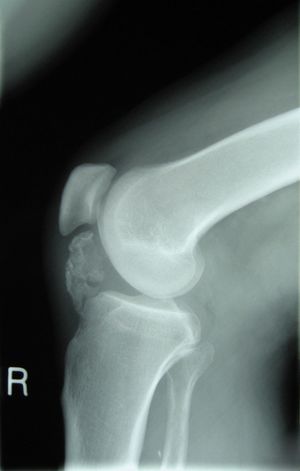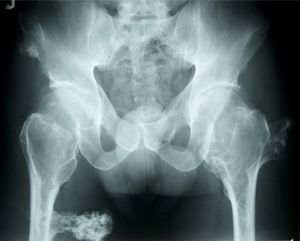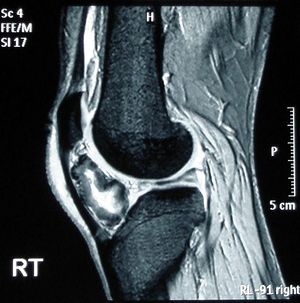Osteochondroma: Difference between revisions
No edit summary |
Leana Louw (talk | contribs) No edit summary |
||
| (31 intermediate revisions by 8 users not shown) | |||
| Line 1: | Line 1: | ||
<div class="editorbox"> | |||
'''Original Editors '''- [[User:James Mountain|James Mountain]] | |||
'''Original Editors '''- James Mountain | |||
''' | '''Top Contributors''' - {{Special:Contributors/{{FULLPAGENAME}}}} | ||
</div> | </div> | ||
== Definition/Description == | |||
These tumors may present with a stalk-like structure and are known as pedunculated. Osteochondromas without a stalk are called sessile exostoses<ref name="AAOS" /><ref name="Yoshiba" /> | Osteochondroma, also referred to as osteocartilaginous exostosis or plainly exostosis, is the most common benign bone tumor.<ref name="Merck">Merck Manuals. Bone and joint tumors. Merck Manual Home Edition. Available from: http://www.merckmanuals.com/professional/sec04/ch044/ch044b.html (accessed 23/02/2011).</ref><ref name="AAOS">American Academy of Orthopaedic Surgeons. Osteochondroma (bone tumor). Available from:http://orthoinfo.aaos.org/topic.cfm?topic=A00079. 2007 (accessed 16/03/2011).</ref><ref name="Murphey">Murphey MD, Choi JJ, Kransdorf MJ, Flemming DJ, Gannon FH. [https://pubs.rsna.org/doi/full/10.1148/radiographics.20.5.g00se171407 Imaging of osteochondroma: variants and complications with radiologic-pathologic correlation.] Radiographics 2000;20(5):1407-34.</ref><ref name="Samartzis">Samartzis D, Marco R. [https://journals.lww.com/spinejournal/Abstract/2006/06010/Osteochondroma_of_the_Sacrum__A_Case_Report_and.29.aspx Osteochondroma of the sacrum: a case report and review of the literature.] Spine 2006;31(13):425-429.</ref><ref name="Goodman">Goodman CC, Snyder TK. Differential Diagnosis for Physical Therapists: Screening for Referral. 4th edition. St. Louis, Missouri: Saunders Elsevier, 2007.</ref><ref name="Frey">Hubbard T, Frey KM, Hosey RG, Milbrandt T. Tibial Osteochondroma in a High School Football Player. Athletic Therapy Today 2008;13(6):36-7.</ref> It can present as solitory osteochondroma or as multiple osteochondromatosis.<ref name="AAOS" /> Osteochondromas usually arise from the metaphysis of long bones, but can occur at other cortical bone metaphyses.<ref name="moon">Moon K, Lee J, Kim Y, Kwak H, Joo S, Kim I, Kim J, Kim S. [https://www.karger.com/Article/Abstract/94067 Osteochondroma of the cervical spine extending multiple segments with cord compression.] Pediatric Neurosurgery 2006;42:304-307.</ref><ref name="Ratliff">Ratliff J, Voorhies R. [https://journals.lww.com/spinejournal/Abstract/2000/05150/Osteochondroma_of_the_C5_Lamina_With_Cord.17.aspx Osteochondroma of the C5 lamina with cord compression: case report and review of the literature.] Spine 2000; 25(10):1293-1295.</ref><ref name="roa">Roa A, Abraham G, Rajshekhar V. [https://search.proquest.com/openview/beb5b8c22ab118566b69c965a2cc229a/1?pq-origsite=gscholar&cbl=28294 Osteochondroma of rib with neural foraminal extension and cord compression]. Neurology India 2007;55(4):428-429.</ref> The most common sites for these tumors are the distal [[femur]], proximal [[humerus]], and proximal [[tibia]]. They can also be in flat bones, such as the ilium and [[scapula]]<ref name="Goodman" />, and rarely affect the spine<ref name="moon" />. It is believed that these non-malignant tumors arise from unusual cartilaginous epiphyseal growth-plate tissue that spreads and grows by endochondral ossification.<ref name="Chin">Chin K, Kharrazi F, Miller B, Mankin H, Gebhardt M. [https://journals.lww.com/jbjsjournal/Abstract/2000/09000/Osteochondromas_of_the_Distal_Aspect_of_the_Tibia.7.aspx Osteochondromas of the distal aspect of the tibia or fibula.] Journal of Bone and Joint Surgery 2000;82:1269.</ref> These tumors may present with a stalk-like structure and are known as pedunculated. Osteochondromas without a stalk are called sessile exostoses.<ref name="AAOS" /><ref name="Yoshiba">Yoshida T, Matsuda H, Horiuchi C, Taguchi T, Nagao J, Aota Y, Honda A, Tsukuda M. [https://www.tandfonline.com/doi/abs/10.1080/00016480500416793 A case of osteochondroma of the atlas causing obstructive sleep apnea syndrome.] Acta Oto-Laryngologica 2006;126:445-448.</ref> | ||
== Epidemiology/Etiology == | |||
< | === Epidemiology === | ||
Average age of clinical presentation is between 10 and 30.<ref name="AAOS" /><ref name="moon" /><ref name="Chin" /><ref name="Ratliff" /> These tumors account for 10%-15% of all bone tumors<ref name="Murphey" />, while representing 36% of all non-malignant bone tumors<ref name="Yoshiba" /> Solitary osteochondroma occur equally in males and females,<ref name="AAOS" /> while multiple osteochondroma affects males more than females,<ref name="AAOS" /> approximately 1,6:1.<ref name="Chin" /> Malignant transformation from osteochondroma to [[osteosarcoma]] is possible in both solitary and multiple osteochondroma. This happens in approximately 1% of solitay osteochondroma cases<ref name="Merck" /><ref name="roa" /><ref name="Errani" /> and 5-25% in multiple osteochondromas.<ref name="Merck" /><ref name="Woertler" /> | |||
=== Etiology === | |||
The etiology regarding the development of solitary osteochondroma is currently unknown<ref name="Frey" />. Multiple osteochondromatosis, on the other hand, does apear to have a genetic link. It is inherited in 70% of cases and has been associated with EXT 1 and EXT 2 genes. The association is currently not well understood and research is continuing to look into the link<ref name="AAOS" />. | |||
[[File:Osteochondroma X-ray.jpg|thumb]] | |||
== | |||
== Characteristics/Clinical Presentation == | == Characteristics/Clinical Presentation == | ||
Osteochondromas are usually asymptomatic and present most commonly as a painless bump near a joint, usually the knee or the shoulder. Other symptoms may present and are usually associated with the location of the osteochondroma. If the osteochondroma is located under a tendon, it may cause a snapping effect with activity as the tendon moves over the tumor. Additional symptoms may present if the osteochondroma is located near nerves and blood vessels. For example, a tumor on the posterior aspect of the knee may result in numbness and tingling, periodic changes in blood flow, loss of pulse, or colour change in the limb secondary to nerve and blood vessel compression.<ref name="AAOS" /> | Osteochondromas are usually asymptomatic and present most commonly as a painless bump near a joint, usually the [[knee]] or the [[shoulder]]. Other symptoms may present and are usually associated with the location of the osteochondroma. If the osteochondroma is located under a tendon, it may cause a snapping effect with activity as the tendon moves over the tumor. Additional symptoms may present if the osteochondroma is located near nerves and blood vessels. For example, a tumor on the posterior aspect of the [[knee]] may result in numbness and tingling, periodic changes in blood flow, loss of pulse, or colour change in the limb secondary to nerve and blood vessel compression.<ref name="AAOS" /> | ||
=== Symptoms === | |||
* Painless, palpable mass near a joint - [[knee]] and [[shoulder]] most commonly | |||
* Numbness and tingling | |||
* Snapping of tendon over tumor | |||
* Restricted range of motion | |||
* Period changes in blood flow | |||
* Loss of pulse in affected limb due to vascular compression | |||
* Colour change in limb due to vascular compression | |||
<ref name="AAOS" /><ref name="Murphey" /><ref name="Goodman" /><ref name="moon" /><ref name="Chin" /><ref name="Errani">Errani C, Jutte P, De Paolis M, Bacchini P, Mercuri M. [https://www.tandfonline.com/doi/full/10.1080/17453670710014446 Secondary synovial condromatosis in a bursa overlying an osteochondroma mimicking a peripheral chondrosarcoma-a case report.] Acta Orthopaedica 2007;78(5):701-704.</ref><ref name="Robbins">Robbins M, Kuo S, Epstein R. [https://www.sciencedirect.com/science/article/pii/S1930043315301679 Non-traumatic fracture of an osteochondroma mimicking malignant degeneration in an adult with hereditary multiple exostoses.] Radiology Case Reports 2008;3:99.</ref><br> | |||
=== Complications === | |||
* Vascular compression | |||
* [[Radiculopathy]] secondary to spinal tumors<ref name="moon" /> | |||
* [[Myelopathy]] secondary to spinal tumors<ref name="moon" /> | |||
* Bursa formation | |||
* Pathological fracture - most of which occur at the [[knee]] (distal [[femur]] or proximal [[tibia]])<ref name="Robbins" /> | |||
* Infarction | |||
* [[Osteomyelitis]] | |||
<ref name="AAOS" /><ref name="Murphey" /><ref name="Goodman" /><ref name="moon" /><ref name="Chin" /><ref name="Errani" /><ref name="Robbins" /> | |||
== Differential diagnosis == | |||
* [[Myelopathy]] | |||
* [[Radiculopathy]] | |||
* [[Osteosarcoma]] | |||
* [[Osteomyelitis]] | |||
== Diagnostic procedures == | |||
*[[X-Rays]]: Most commonly used to diagnose osteochondroma | |||
**Excess bone growth visible<ref name="AAOS" /><ref name="Goodman" /> | |||
[[File:Multiple osteosarcomas.jpg|none|thumb]] | |||
'''<u></u>''' | |||
*[[MRI Scans|MRI]]: Examine whether or not cartilage is present on the surface of the exostosis<ref name="Woertler">Woertler K, Lindner N, Gosheger G, Brinkschmidt C, Heindel W. [https://link.springer.com/article/10.1007/s003300051014 Osteochondroma: MR imaging of tumor-related complications.] European Radiology 2000;10(5):832-840.</ref> | |||
[[File:Osteochondroma MRI.JPEG|none|thumb]]'''<u></u>''' | |||
*[[CT Scans|CT]]: Evaluate the presence and physical characteristics of an osteochondroma<ref name="AAOS" /> | |||
**Not commonly used<ref name="Goodman" /> | |||
== Medical management == | |||
Options regarding medical management of osteochondroma is indicated only if symptoms are present and depends on a variety of factors including age, severity, disease extent, and overall health. Observation is the best way to manage a non-symptomatic osteochondroma.<ref name="Goodman" /><ref name="AAOS" /> Medical treatment is usually not indicated for osteochondroma, since most times the condition is asymptomatic. Pain medication is only used if symptoms of pain present. Observation and regular monitoring is very important.<ref name="AAOS" /> | |||
If symptoms are present, the medical options include: | |||
* Analgesia | |||
* Surgery | |||
| |||
=== Solitary osteochondromas === | |||
Solitary ostechandromas generally do not require surgery and are usually monitored with regular [[X-Rays|X-rays]]. Surgery for solitary osteochondromas are only suggested when the exostosis has grown completely and a mature skeleton is observed on [[X-Rays|X-ray]]. The reason for this is to decrease the chance of reccurrence.<u></u> | |||
Surgery may be considered when: | |||
* Pain is experienced with activity | |||
* Pressure on a nerve or blood vessel | |||
* Presence of a larger cartilage cap | |||
* Bone growth has fully matured | |||
| |||
=== Multiple osteochondromas === | |||
Surgical removal is not indicated in multiple osteochondromas unless symptoms exist. It is very important to monitor multiple osteochondromas. If surgery is indicated, the tumor may be completely removed and a prosthesis may have to be used to replace any structural loss.<ref name="AAOS" /> | |||
== Physiotherapy management == | |||
Physiotherapy is indicated most commonly for post-operative osteochondroma cases. Functional mobility will be the primary focus with the treatment addressing range of motion, strength, restoring proper biomechanics.<ref name="Chin" /> | |||
== Resources == | |||
* [http://orthoinfo.aaos.org/topic.cfm?topic=A00079 Osteochondroma] | |||
* [http://emedicine.medscape.com/article/1256477-overview Solitary osteochondroma] | |||
* [http://www.merckmanuals.com/professional/sec04/ch044/ch044b.html?qt=Thygeson%2520superficial%2520punctate%2520keratitis&alt=sh Benign bone tumors and cysts] | |||
== Clinical bottom line == | |||
Osteochondroma presents as either solitary or multiple, and is the most common benign bone tumor. It commonly occurs in the proximal tibia, proximal humerus and proximal tibia, but can also occur in flat bones, and less commonly in the spine. Patients can be asymptomatic, where medical management mostly consist of regular monitoring of the condition with X-rays. Surgical excision can be considered in a mature skeleton, where after physiotherapy will play a role in the post-operative management. | |||
== References == | |||
<references /> | <references /> | ||
[[Category: | [[Category:Oncology]] | ||
[[Category:Medical]] | |||
[[Category:Primary Contact]] | |||
Latest revision as of 17:33, 27 January 2019
Original Editors - James Mountain
Top Contributors - James Mountain, Leana Louw, Admin, Elaine Lonnemann, WikiSysop, Claire Knott, Lydia Xenou and Mariam Hashem
Definition/Description[edit | edit source]
Osteochondroma, also referred to as osteocartilaginous exostosis or plainly exostosis, is the most common benign bone tumor.[1][2][3][4][5][6] It can present as solitory osteochondroma or as multiple osteochondromatosis.[2] Osteochondromas usually arise from the metaphysis of long bones, but can occur at other cortical bone metaphyses.[7][8][9] The most common sites for these tumors are the distal femur, proximal humerus, and proximal tibia. They can also be in flat bones, such as the ilium and scapula[5], and rarely affect the spine[7]. It is believed that these non-malignant tumors arise from unusual cartilaginous epiphyseal growth-plate tissue that spreads and grows by endochondral ossification.[10] These tumors may present with a stalk-like structure and are known as pedunculated. Osteochondromas without a stalk are called sessile exostoses.[2][11]
Epidemiology/Etiology[edit | edit source]
Epidemiology[edit | edit source]
Average age of clinical presentation is between 10 and 30.[2][7][10][8] These tumors account for 10%-15% of all bone tumors[3], while representing 36% of all non-malignant bone tumors[11] Solitary osteochondroma occur equally in males and females,[2] while multiple osteochondroma affects males more than females,[2] approximately 1,6:1.[10] Malignant transformation from osteochondroma to osteosarcoma is possible in both solitary and multiple osteochondroma. This happens in approximately 1% of solitay osteochondroma cases[1][9][12] and 5-25% in multiple osteochondromas.[1][13]
Etiology[edit | edit source]
The etiology regarding the development of solitary osteochondroma is currently unknown[6]. Multiple osteochondromatosis, on the other hand, does apear to have a genetic link. It is inherited in 70% of cases and has been associated with EXT 1 and EXT 2 genes. The association is currently not well understood and research is continuing to look into the link[2].
Characteristics/Clinical Presentation[edit | edit source]
Osteochondromas are usually asymptomatic and present most commonly as a painless bump near a joint, usually the knee or the shoulder. Other symptoms may present and are usually associated with the location of the osteochondroma. If the osteochondroma is located under a tendon, it may cause a snapping effect with activity as the tendon moves over the tumor. Additional symptoms may present if the osteochondroma is located near nerves and blood vessels. For example, a tumor on the posterior aspect of the knee may result in numbness and tingling, periodic changes in blood flow, loss of pulse, or colour change in the limb secondary to nerve and blood vessel compression.[2]
Symptoms[edit | edit source]
- Painless, palpable mass near a joint - knee and shoulder most commonly
- Numbness and tingling
- Snapping of tendon over tumor
- Restricted range of motion
- Period changes in blood flow
- Loss of pulse in affected limb due to vascular compression
- Colour change in limb due to vascular compression
Complications[edit | edit source]
- Vascular compression
- Radiculopathy secondary to spinal tumors[7]
- Myelopathy secondary to spinal tumors[7]
- Bursa formation
- Pathological fracture - most of which occur at the knee (distal femur or proximal tibia)[14]
- Infarction
- Osteomyelitis
Differential diagnosis[edit | edit source]
Diagnostic procedures[edit | edit source]
Medical management[edit | edit source]
Options regarding medical management of osteochondroma is indicated only if symptoms are present and depends on a variety of factors including age, severity, disease extent, and overall health. Observation is the best way to manage a non-symptomatic osteochondroma.[5][2] Medical treatment is usually not indicated for osteochondroma, since most times the condition is asymptomatic. Pain medication is only used if symptoms of pain present. Observation and regular monitoring is very important.[2]
If symptoms are present, the medical options include:
- Analgesia
- Surgery
Solitary osteochondromas[edit | edit source]
Solitary ostechandromas generally do not require surgery and are usually monitored with regular X-rays. Surgery for solitary osteochondromas are only suggested when the exostosis has grown completely and a mature skeleton is observed on X-ray. The reason for this is to decrease the chance of reccurrence.
Surgery may be considered when:
- Pain is experienced with activity
- Pressure on a nerve or blood vessel
- Presence of a larger cartilage cap
- Bone growth has fully matured
Multiple osteochondromas[edit | edit source]
Surgical removal is not indicated in multiple osteochondromas unless symptoms exist. It is very important to monitor multiple osteochondromas. If surgery is indicated, the tumor may be completely removed and a prosthesis may have to be used to replace any structural loss.[2]
Physiotherapy management[edit | edit source]
Physiotherapy is indicated most commonly for post-operative osteochondroma cases. Functional mobility will be the primary focus with the treatment addressing range of motion, strength, restoring proper biomechanics.[10]
Resources[edit | edit source]
Clinical bottom line[edit | edit source]
Osteochondroma presents as either solitary or multiple, and is the most common benign bone tumor. It commonly occurs in the proximal tibia, proximal humerus and proximal tibia, but can also occur in flat bones, and less commonly in the spine. Patients can be asymptomatic, where medical management mostly consist of regular monitoring of the condition with X-rays. Surgical excision can be considered in a mature skeleton, where after physiotherapy will play a role in the post-operative management.
References[edit | edit source]
- ↑ 1.0 1.1 1.2 Merck Manuals. Bone and joint tumors. Merck Manual Home Edition. Available from: http://www.merckmanuals.com/professional/sec04/ch044/ch044b.html (accessed 23/02/2011).
- ↑ 2.00 2.01 2.02 2.03 2.04 2.05 2.06 2.07 2.08 2.09 2.10 2.11 2.12 2.13 2.14 American Academy of Orthopaedic Surgeons. Osteochondroma (bone tumor). Available from:http://orthoinfo.aaos.org/topic.cfm?topic=A00079. 2007 (accessed 16/03/2011).
- ↑ 3.0 3.1 3.2 3.3 Murphey MD, Choi JJ, Kransdorf MJ, Flemming DJ, Gannon FH. Imaging of osteochondroma: variants and complications with radiologic-pathologic correlation. Radiographics 2000;20(5):1407-34.
- ↑ Samartzis D, Marco R. Osteochondroma of the sacrum: a case report and review of the literature. Spine 2006;31(13):425-429.
- ↑ 5.0 5.1 5.2 5.3 5.4 5.5 5.6 Goodman CC, Snyder TK. Differential Diagnosis for Physical Therapists: Screening for Referral. 4th edition. St. Louis, Missouri: Saunders Elsevier, 2007.
- ↑ 6.0 6.1 Hubbard T, Frey KM, Hosey RG, Milbrandt T. Tibial Osteochondroma in a High School Football Player. Athletic Therapy Today 2008;13(6):36-7.
- ↑ 7.0 7.1 7.2 7.3 7.4 7.5 7.6 Moon K, Lee J, Kim Y, Kwak H, Joo S, Kim I, Kim J, Kim S. Osteochondroma of the cervical spine extending multiple segments with cord compression. Pediatric Neurosurgery 2006;42:304-307.
- ↑ 8.0 8.1 Ratliff J, Voorhies R. Osteochondroma of the C5 lamina with cord compression: case report and review of the literature. Spine 2000; 25(10):1293-1295.
- ↑ 9.0 9.1 Roa A, Abraham G, Rajshekhar V. Osteochondroma of rib with neural foraminal extension and cord compression. Neurology India 2007;55(4):428-429.
- ↑ 10.0 10.1 10.2 10.3 10.4 10.5 Chin K, Kharrazi F, Miller B, Mankin H, Gebhardt M. Osteochondromas of the distal aspect of the tibia or fibula. Journal of Bone and Joint Surgery 2000;82:1269.
- ↑ 11.0 11.1 Yoshida T, Matsuda H, Horiuchi C, Taguchi T, Nagao J, Aota Y, Honda A, Tsukuda M. A case of osteochondroma of the atlas causing obstructive sleep apnea syndrome. Acta Oto-Laryngologica 2006;126:445-448.
- ↑ 12.0 12.1 12.2 Errani C, Jutte P, De Paolis M, Bacchini P, Mercuri M. Secondary synovial condromatosis in a bursa overlying an osteochondroma mimicking a peripheral chondrosarcoma-a case report. Acta Orthopaedica 2007;78(5):701-704.
- ↑ 13.0 13.1 Woertler K, Lindner N, Gosheger G, Brinkschmidt C, Heindel W. Osteochondroma: MR imaging of tumor-related complications. European Radiology 2000;10(5):832-840.
- ↑ 14.0 14.1 14.2 Robbins M, Kuo S, Epstein R. Non-traumatic fracture of an osteochondroma mimicking malignant degeneration in an adult with hereditary multiple exostoses. Radiology Case Reports 2008;3:99.









